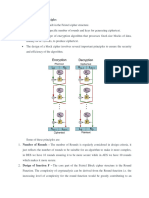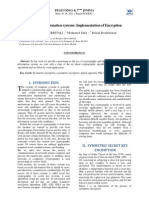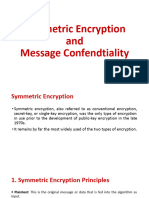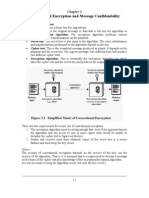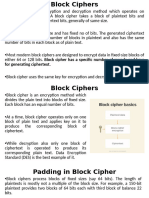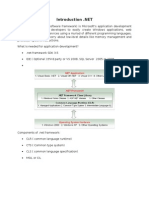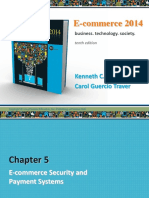Encryption Algorithms and Digital Signatures
Uploaded by
Prateek MahajanEncryption Algorithms and Digital Signatures
Uploaded by
Prateek MahajanEncryption Algorithms And Digital Signatures
Encryption...is a powerful defensive weapon for free people. It offers a technical guarantee of privacy, regardless of who is running the government... It's hard to think of a more powerful, less dangerous tool for liberty. Esther Dyson
Encryption: In cryptography, encryption is the process of transforming information (referred to as plaintext) using an algorithm (called cipher) to make it unreadable to anyone except those possessing special knowledge, usually referred to as a key. The result of the process is encrypted information (in cryptography, referred to as ciphertext). In many contexts, the word encryption also implicitly refers to the reverse process, decryption (e.g. software for encryption can typically also perform decryption), to make the encrypted information readable again (i.e. to make it unencrypted). Encryption has long been used by militaries and governments to facilitate secret communication. Encryption is now commonly used in protecting information within many kinds of civilian systems. For example, the Computer Security Institute reported that in 2007, 71% of companies surveyed utilized encryption for some of their data in transit, and 53% utilized encryption for some of their data in storage. Encryption can be used to protect data "at rest", such as files on computers and storage devices (e.g. USB flash drives). In recent years there have been numerous reports of confidential data such as customers' personal records being exposed through loss or theft of laptops or backup drives. Encrypting such files at rest helps protect them should physical security measures fail. Digital rights management systems which prevent unauthorized use or reproduction of copyrighted material and protect software against reverse engineering (see also copy protection) are another somewhat different example of using encryption on data at rest. Various Encryption Algorithms : There are of course a wide range of cryptographic algorithms in use. The following are amongst the most well known: ADVANCED ENCRYPTION STANDARD (AES) RSA DATA ENCRYPTION STANDARD (DES) MD5 SHA FUNCTION HMAC DES DES (the Data Encryption Standard) is a symmetric block cipher developed by IBM. The algorithm uses a 56-bit key to encipher/decipher a 64-bit block of data. The key is always presented as a 64-bit block, every 8th bit of which is ignored. However, it is usual to set each 8th bit so that each group of 8 bits has an odd number of bits set to 1. The algorithm is best suited to implementation in hardware, probably to discourage implementations in software, which tend to be slow by comparison. However, modern computers are so fast that satisfactory software implementations are readily available. DES is the most widely used symmetric algorithm in the world, despite claims that the key length is too short. Ever since DES was first announced, controversy has raged about whether 56 bits is long enough to guarantee security. The key length argument goes like this. Assuming that the only feasible attack on DES is to try each key in turn until the right one is found, then 1,000,000 machines each
capable of testing 1,000,000 keys per second would find (on average) one key every 12 hours. Most reasonable people might find this rather comforting and a good measure of the strength of the algorithm. Those who consider the exhaustive key-search attack to be a real possibility (and to be fair the technology to do such a search is becoming a reality) can overcome the problem by using double or triple length keys. In fact, double length keys have been recommended for the financial industry for many years. Use of multiple length keys leads us to the Triple-DES algorithm, in which DES is applied three times. If we consider a triple length key to consist of three 56-bit keys K1, K2, K3 then encryption is as follows: Encrypt with K1 Decrypt with K2 Encrypt with K3 Decryption is the reverse process: Decrypt with K3 Encrypt with K2 Decrypt with K1 Setting K3 equal to K1 in these processes gives us a double length key K1, K2. Setting K1, K2 and K3 all equal to K has the same effect as using a single-length (56-bit key). Thus it is possible for a system using triple-DES to be compatible with a system using single-DES. RSA RSA is a public key algorithm invented by Rivest, Shamir and Adleman. The key used for encryption is different from (but related to) the key used for decryption. The algorithm is based on modular exponentiation. Numbers e, d and N are chosen with the property that if A is a number less than N, then (Ae mod N)d mod N = A. This means that you can encrypt A with e and decrypt using d. Conversely you can encrypt using d and decrypt using e (though doing it this way round is usually referred to as signing and verification). The pair of numbers (e,N) is known as the public key and can be published. The pair of numbers (d,N) is known as the private key and must be kept secret. The number e is known as the public exponent, the number d is known as the private exponent, and N is known as the modulus. When talking of key lengths in connection with RSA, what is meant is the modulus length. An algorithm that uses different keys for encryption and decryption is said to be asymmetric. Anybody knowing the public key can use it to create encrypted messages, but only the owner of the secret key can decrypt them. Conversely the owner of the secret key can encrypt messages that can be decrypted by anybody with the public key. Anybody successfully decrypting such messages can be sure that only the owner of the secret key could have encrypted them. This fact is the basis of the digital signature technique. Without going into detail about how e, d and N are related, d can be deduced from e and N if the factors of N can be determined. Therefore the security of RSA depends on the difficulty of factorizing N. Because factorization is believed to be a hard problem, the longer N is, the more secure the cryptosystem. Given the power of modern computers,
a length of 768 bits is considered reasonably safe, but for serious commercial use 1024 bits is recommended. The problem with choosing long keys is that RSA is very slow compared with a symmetric block cipher such as DES, and the longer the key the slower it is. The best solution is to use RSA for digital signatures and for protecting DES keys. Bulk data encryption should be done using DES. Advanced Encryption Standard(AES) The Advanced Encryption Standard (AES) is a computer security standard that became effective on May 26, 2002 by NIST to replace DES. The cryptography scheme is a symmetric block cipher that encrypts and decrypts 128-bit blocks of data.Lengths of 128, 192, and 256 bits are standard key lengths used by AES. The algorithm consists of four stages that make up a round which is iterated 10 times for a 128-bit length key, 12 times for a 192-bit key, and 14 times for a 256-bit key. The first stage "SubBytes" transformation is a non-linear byte substitution for each byte of the block. The second stage "ShiftRows" transformation cyclically shifts (permutes) the bytes within the block. The third stage "MixColumns" transformation groups 4-bytes together forming 4-term polynomials and multiplies the polynomials with a fixed polynomial mod (x^4+1). The fourth stage "AddRoundKey" transformation adds the round key with the block of data. In most ciphers, the iterated transform (or round) usually has a Feistel Structure. Typically in this structure, some of the bits of the intermediate state are transposed unchanged to another position (permutation). AES does not have a Feistel structure but is composed of three distinct invertible transforms based on the Wide Trial Strategy design method. The Wide Trial Strategy design method provides resistance against linear and differential cryptanalysis. In the Wide Trail Strategy, every layer has its own function: The linear mixing layer: guarantees high diffusion over multiply rounds The non-linear layer: parallel application of S-boxes that have the optimum worstcase non-linearity properties. The key addition layer: a simple XOR of the round key to the intermediate state Terminology Plaintext refers to the data to be encrypted. Ciphertext refers to the data after going through the cipher as well as the data that will be going into the decipher. The state is an intermediate form of the cipher or deciphers result usually displayed as a rectangular table of bytes with 4 rows and 4 columns. Features Key lengths of 128, 192, and 256 bits are supported. Each step in key size requires only two additional rounds. The decipher is simply the inverse of the cipher. Cryptographic hash function A cryptographic hash function is a deterministic procedure that takes an arbitrary block of data and returns a fixed-size bit string, the (cryptographic) hash value, such that an accidental or intentional change to the data will change the hash value. The data
to be encoded is often called the "message", and the hash value is sometimes called the message digest or simply digests. The ideal cryptographic hash function has four main or significant properties: _ it is easy to compute the hash value for any given message, _ it is infeasible to find a message that has a given hash, _ it is infeasible to modify a message without changing its hash, _ it is infeasible to find two different messages with the same hash. Cryptographic hash functions have many information security applications, notably in digital signatures, message authentication codes (MACs), and other forms of authentication. They can also be used as ordinary hash functions, to index data in hash tables, for fingerprinting, to detect duplicate data or uniquely identify files, and as checksums to detect accidental data corruption. Indeed, in information security contexts, cryptographic hash values are sometimes called (digital) fingerprints, checksums, or just hash values, even though all these terms stand for functions with rather different properties and purposes. Properties Most cryptographic hash functions are designed to take a string of any length as input and produce a fixed-length hash value. A cryptographic hash function must be able to withstand all known types of cryptanalytic attack. As a minimum, it must have the following properties: _ Preimage resistance: given a hash h it should be hard to find any message m such that h = hash(m). This concept is related to that of one way function. Functions that lack this property are vulnerable to preimage attacks. _ Second preimage resistance: given an input m1, it should be hard to find another input, m2 (not equal to m1) such that hash(m1) = hash(m2). This property is sometimes referred to asweak collision resistance. Functions that lack this property are vulnerable to second preimage attacks. _ Collision resistance: it should be hard to find two different messages m1 and m2 such that hash(m1) = hash(m2). Such a pair is called a (cryptographic) hash collision, and this property is sometimes referred to as strong collision resistance. It requires a hash value at least twice as long as what is required for preimage-resistance, otherwise collisions may be found by abirthday attack. These properties imply that a malicious adversary cannot replace or modify the input data without changing its digest. Thus, if two strings have the same digest, one can be very confident that they are identical. A function meeting these criteria may still have undesirable properties. Currently popular cryptographic hash functions are vulnerable to length-extension attacks: given h(m) and len(m) but not m, by choosing a suitable m' an attacker can calculate h (m || m'), where || denotes concatenation. This property can be used to break naive authentication schemes based on hash functions. The HMAC construction works around these problems. Ideally, one may wish for even stronger conditions. It should be impossible for an adversary to find two messages with substantially similar digests; or to infer any useful information about the data, given only its digest. Therefore, a cryptographic hash function should behave as much as possible like a random function while still being
deterministic and efficiently computable. Checksum algorithms, such as CRC32 and other cyclic redundancy checks, are designed to meet much weaker requirements, and are generally unsuitable as cryptographic hash functions. For example, a CRC was used for message integrity in the WEP encryption standard, but an attack was readily discovered which exploited the linearity of the checksum. MD5: In cryptography, MD5 (Message-Digest algorithm 5) is a widely used cryptographic hash function with a 128-bit hash value. Specified in RFC 1321, MD5 has been employed in a wide variety of security applications, and is also commonly used to check the integrity of files. However, it has been shown that MD5 is not collision resistant; as such, MD5 is not suitable for applications like SSL certificates or digital signaturesthat rely on this property. An MD5 hash is typically expressed as a 32digit hexadecimal number. MD5 was designed by Ron Rivest in 1991 to replace an earlier hash function, MD4. In 1996, a flaw was found with the design of MD5. While it was not a clearly fatal weakness, cryptographers began recommending the use of other algorithms, such as SHA-1 (which has since been found also to be vulnerable). In 2004, more serious flaws were discovered, making further use of the algorithm for security purposes questionable. In 2007 a group of researchers described how to create a pair of files that share the same MD5 checksum. In an attack on MD5 published in December 2008, a group of researchers used this technique to fake SSL certificate validity. US-CERT of the U. S.Department of Homeland Security said MD5 "should be considered cryptographically broken and unsuitable for further use," and most U.S. government applications will be required to move to the SHA-2 family of hash functions after 2010. Algorithm MD5 processes a variable-length message into a fixed-length output of 128 bits. The input message is broken up into chunks of 512-bit blocks (sixteen 32-bit little endian integers); the message is padded so that its length is divisible by 512. The padding works as follows: first a single bit, 1, is appended to the end of the message. This is followed by as many zeros as are required to bring the length of the message up to 64 bits fewer than a multiple of 512. The remaining bits are filled up with a 64-bit integer representing the length of the original message, in bits. The main MD5 algorithm operates on a 128-bit state, divided into four 32-bit words, denoted A, B, C and D. These are initialized to certain fixed constants. The main algorithm then operates on each 512-bit message block in turn, each block modifying the state. The processing of a message block consists of four similar stages, termed rounds; each round is composed of 16 similar operations based on a non-linear function F, modular addition, and left rotation. Figure 1 illustrates one operation within a round. There are four possible functions F; a different one is used in each round: denote the XOR, AND, OR and NOT operations respectively. Security The security of the MD5 hash function is severely compromised. A collision attack exists that can find collisions within seconds on a regular computer (complexity of 224.1). Further, there is also a chosen-prefix collision attack that can produce a collision
for two chosen arbitrarily different inputs, within hours on a single regular computer (complexity 239). These collision attacks have been demonstrated in the public in various situations, including colliding document files and digital certificates. As of 2009, a theoretical attack also breaks MD5's preimage resistance. Collision vulnerabilities In 1995, collisions were found in the compression function of MD5, and Hans Dobbertin wrote in the RSA Laboratories technical newsletter, "The presented attack does not yet threaten practical applications of MD5, but it comes rather close ... in the future MD5 should no longer be implemented...where a collision-resistant hash function is required." In 2005, researchers were able to create pairs of PostScript documents[18] and X.509 certificates with the same hash. Later that year, MD5's designer Ron Rivest wrote, "md5 and sha1 are both clearly broken (in terms of collision-resistance), and RSA Laboratories wrote that "[n]ext-generation products will need to move to new algorithms. On 30 December 2008, a group of researchers announced at the 25th Chaos Communication Congress how they had used MD5 collisions to create an intermediate certificate authority certificate which appeared to be legitimate when checked via its MD5 hash. The researchers used a cluster of Sony Playstation 3s at the EPFL in Lausanne, Switzerland to change a normal SSL certificate issued by RapidSSL into a working CA certificate for that issuer, which could then be used to create other certificates that would appear to be legitimate and issued by RapidSSL. VeriSign, the issuers of RapidSSL certificates, said they stopped issuing new certificates using MD5 as their checksum algorithm for RapidSSL once the vulnerability was announced. Although Verisign declined to revoke existing certificates signed using MD5, their response was considered adequate by the authors of the exploit (Alexander Sotirov, Marc Stevens, Jacob Appelbaum, Arjen Lenstra, David Molnar, Dag Arne Osvik, and Benne de Weger. Bruce Schneier wrote of the attack that "[w]e already knew that MD5 is a broken hash function" and that "no one should be using MD5 anymore. The SSL researchers wrote, "Our desired impact is that Certification Authorities will stop using MD5 in issuing new certificates. We also hope that use of MD5 in other applications will be reconsidered as well." MD5 makes only one pass over the data, so if two prefixes with the same hash can be constructed, a common suffix can be added to both to make the collision more likely to be accepted as valid data by the application using it. Furthermore, current collisionfinding techniques allow to specify an arbitrary prefix: an attacker can create two colliding files that both begin with the same content. All the attacker needs to generate two colliding files is a template file with a 128-byte block of data aligned on a 64-byte boundary that can be changed freely by the collision-finding algorithm. Preimage vulnerability In April 2009, a preimage attack against MD5 was published that breaks MD5's preimage resistance. This attack is only theoretical, with a computational complexity of 2123.4 for full preimage and 2116.9 for a pseudo-preimage. Other vulnerabilities A number of projects have published MD5 rainbow tables online, that can be used to
reverse many MD5 hashes into strings that collide with the original input, usually for the purposes ofpassword cracking. The use of MD5 in some websites' URLs means that search engines such as Google can also sometimes function as a limited tool for reverse lookup of MD5 hashes. Both this techniques are rendered ineffective by the use of a sufficiently long salt. DIGITAL SIGNATURE A digital signature or digital signature scheme is a mathematical scheme for demonstrating the authenticity of a digital message or document. A valid digital signature gives a recipient reason to believe that the message was created by a known sender, and that it was not altered in transit. Digital signatures are commonly used for software distribution, financial transactions, and in other cases where it is important to detect forgery and tampering. Digital signatures are often used to implement electronic signatures, a broader term that refers to any electronic data that carries the intent of a signature, but not all electronic signatures use digital signatures. In some countries, including the United States, and members of the European Union, electronic signatures have legal significance. However, laws concerning electronic signatures do not always make clear whether they are digital cryptographic signatures in the sense used here, leaving the legal definition, and so their importance, somewhat confused. Digital signatures employ a type of asymmetric cryptography. For messages sent through an insecure channel, a properly implemented digital signature gives the receiver reason to believe the message was sent by the claimed sender. Digital signatures are equivalent to traditional handwritten signatures in many respects; properly implemented digital signatures are more difficult to forge than the handwritten type. Digital signature schemes in the sense used here are cryptographically based, and must be implemented properly to be effective. Digital signatures can also provide non-repudiation, meaning that the signer cannot successfully claim they did not sign a message, while also claiming their private key remains secret; further, some nonrepudiation schemes offer a time stamp for the digital signature, so that even if the private key is exposed, the signature is valid nonetheless. Digitally signed messages may be anything representable as a bitstring: examples include electronic mail, contracts, or a message sent via some other cryptographic protocol DEFINITION A digital signature scheme typically consists of three algorithms: * A key generation algorithm that selects a private key uniformly at random from a set of possible private keys. The algorithm outputs the private key and a corresponding public key. * A signing algorithm which, given a message and a private key, produces a signature. * A signature verifying algorithm which given a message, public key and a signature, either accepts or rejects the message's claim to authenticity. Two main properties are required. First, a signature generated from a fixed message and fixed private key should verify the authenticity of that message by using the corresponding public key. Secondly, it should be computationally infeasible to generate a valid signature for a party who does not possess the private key. USES OF DIGITAL SIGNATURE Below are some common reasons for applying a digital signature to communications:
Authentication Although messages may often include information about the entity sending a message, that information may not be accurate. Digital signatures can be used to authenticate the source of messages. When ownership of a digital signature secret key is bound to a specific user, a valid signature shows that the message was sent by that user. The importance of high confidence in sender authenticity is especially obvious in a financial context. For example, suppose a bank's branch office sends instructions to the central office requesting a change in the balance of an account. If the central office is not convinced that such a message is truly sent from an authorized source, acting on such a request could be a grave mistake. Integrity In many scenarios, the sender and receiver of a message may have a need for confidence that the message has not been altered during transmission. Although encryption hides the contents of a message, it may be possible to change an encrypted message without understanding it. (Some encryption algorithms, known as nonmalleable ones, prevent this, but others do not.) However, if a message is digitally signed, any change in the message after signature will invalidate the signature. Furthermore, there is no efficient way to modify a message and its signature to produce a new message with a valid signature, because this is still considered to be computationally infeasible by most cryptographic hash functions (see collision resistance). HISTORY In 1976, Whitfield Diffie and Martin Hellman first described the notion of a digital signature scheme, although they only conjectured that such schemes existed. Soon afterwards, Ronald Rivest, Adi Shamir, and Len Adleman invented the RSA algorithm that could be used for primitive digital signatures. (Note that this just serves as a proof-of-concept, and "plain" RSA signatures are not secure.)Other digital signature schemes were soon developed after RSA, the earliest being Lamport signatures, Merkle signatures (also known as "Merkle trees" or simply "Hash trees"), and Rabin signatures. In 1984, Shafi Goldwasser, Silvio Micali, and Ronald Rivest became the first to rigorously define the security requirements of digital signature schemes. They described a hierarchy of attack models for signature schemes, and also present the GMR signature scheme, the first that can be proven to prevent even an existential forgery against a chosen message attack. Most early signature schemes were of a similar type: they involve the use of a trapdoor permutation, such as the RSA functionA trapdoor permutation family is a family of permutations, specified by a parameter, that is easy to compute in the forward direction,but is difficult to compute in the reverse direction without already knowing the private key. However, for every parameter there is a "trapdoor" (private key) which when known, easily decrypts the message. Trapdoor permutations can be viewed as public-key encryption systems, where the parameter is the public key and the trapdoor is the secret key, and where encrypting corresponds to computing the forward direction of the permutation, while decrypting corresponds to the reverse direction. Trapdoor permutations can also be viewed as digital signature schemes, where computing the reverse direction with the secret key is thought of as signing, and computing the forward direction is done to verify signatures. Because of this correspondence, digital signatures are often described as based on public-key cryptosystems,
where signing is equivalent to decryption and verification is equivalent to encryption, but this is not the only way digital signatures are computed. Used directly, this type of signature scheme is vulnerable to a existential forgery attack. NOTIONS OF SECURITY In their foundational paper, Goldwasser, Micali, and Rivest lay out a hierarchy of attack models against digital signatures: 1. In a key-only attack, the attacker is only given the public verification key. 2. In a known message attack, the attacker is given valid signatures for a variety of messages known by the attacker but not chosen by the attacker. 3. In an adaptive chosen message attack, the attacker first learns signatures on arbitrary messages of the attacker's choice. They also describe a hierarchy of attack results: 1. A total break results in the recovery of the signing key. 2. A universal forgery attack results in the ability to forge signatures for any message. 3. A selective forgery attack results in a signature on a message of the adversary's choice. 4. An existential forgery merely results in some valid message/signature pair not already known to the adversary. The strongest notion of security, therefore, is security against existential forgery under an adaptive chosen message attack. ADDITIONAL SECURITY PRECAUTIONS Putting the private key on a smart card All public key / private key cryptosystems depend entirely on keeping the private key secret. A private key can be stored on a user's computer, and protected by a local password, but this has two disadvantages: * The user can only sign documents on that particular computer * The security of the private key depends entirely on the security of the computer A more secure alternative is to store the private key on a smart card. Many smart cards are designed to be tamper-resistant (although some designs have been broken, notably by Ross Anderson and his students). In a typical digital signature implementation, the hash calculated from the document is sent to the smart card, whose CPU encrypts the hash using the stored private key of the user, and then returns the encrypted hash. Typically, a user must activate his smart card by entering a personal identification number or PIN code (thus providing two-factor authentication). It can be arranged that the private key never leaves the smart card, although this is not always implemented. If the smart card is stolen, the thief will still need the PIN code to generate a digital signature. This reduces the security of the scheme to that of the PIN system, although it still requires an attacker to possess the card. A mitigating factor is that private keys, if generated and stored on smart cards, are usually regarded as difficult to copy, and are assumed to exist in exactly one copy. Thus, the loss of the smart card may be detected by the owner and the corresponding certificate can be immediately revoked. Private keys that are protected by software only may be easier to copy, and such compromises are far more difficult to detect. Using digital signatures only with trusted applications One of the main differences between a digital signature and a written signature is that
the user does not "see" what he signs. The user application presents a hash code to be encrypted by the digital signing algorithm using the private key. An attacker who gains control of the user's PC can possibly replace the user application with a foreign substitute, in effect replacing the user's own communications with those of the attacker. This could allow a malicious application to trick a user into signing any document by displaying the user's original on-screen, but presenting the attacker's own documents to the signing application. To protect against this scenario, an authentication system can be set up between the user's application (word processor, email client, etc.) and the signing application. The general idea is to provide some means for both the user app and signing app to verify each other's integrity. For example, the signing application may require all requests to come from digitally-signed binaries. WYSIWYS Technically speaking, a digital signature applies to a string of bits, whereas humans and applications "believe" that they sign the semantic interpretation of those bits. In order to be semantically interpreted the bit string must be transformed into a form that is meaningful for humans and applications, and this is done through a combination of hardware and software based processes on a computer system. The problem is that the semantic interpretation of bits can change as a function of the processes used to transform the bits into semantic content. It is relatively easy to change the interpretation of a digital document by implementing changes on the computer system where the document is being processed. From a semantic perspective this creates uncertainty about what exactly has been signed. WYSIWYS (What You See Is What You Sign) means that the semantic interpretation of a signed message cannot be changed. In particular this also means that a message cannot contain hidden info that the signer is unaware of, and that can be revealed after the signature has been applied. WYSIWYS is a desirable property of digital signatures that is difficult to guarantee because of the increasing complexity of modern computer systems.
You might also like
- Review: - Overview of Cryptography - Classical Symmetric CipherNo ratings yetReview: - Overview of Cryptography - Classical Symmetric Cipher43 pages
- CISSPDomain3xSecurityArchitectureEngineeringwithdetailednotes-191121-071224No ratings yetCISSPDomain3xSecurityArchitectureEngineeringwithdetailednotes-191121-07122420 pages
- (Delfs and Knebl 2015) : Individual Assignment - Im41103 Network SecurityNo ratings yet(Delfs and Knebl 2015) : Individual Assignment - Im41103 Network Security6 pages
- Unit Ii - Block Ciphers & Public Key CryptographyNo ratings yetUnit Ii - Block Ciphers & Public Key Cryptography60 pages
- Security of Information Systems: Implementation of EncryptionNo ratings yetSecurity of Information Systems: Implementation of Encryption6 pages
- Symmetric Encryption - Message ConfidienalityNo ratings yetSymmetric Encryption - Message Confidienality34 pages
- What is the Advanced Encryption Standard (AES) …No ratings yetWhat is the Advanced Encryption Standard (AES) …1 page
- Comparison of Symmetric and Asymmetric Cryptography With Existing Vulnerabilities and CountermeasuresNo ratings yetComparison of Symmetric and Asymmetric Cryptography With Existing Vulnerabilities and Countermeasures4 pages
- The DES Algorithm Illustrated: (Email Reply)No ratings yetThe DES Algorithm Illustrated: (Email Reply)36 pages
- WINSEM2023-24_BCSE309L_TH_VL2023240500759_2024-01-12_Reference-Material-INo ratings yetWINSEM2023-24_BCSE309L_TH_VL2023240500759_2024-01-12_Reference-Material-I57 pages
- 02 - Chapter 2 - Conventional Encryption and Message ConfidentialityNo ratings yet02 - Chapter 2 - Conventional Encryption and Message Confidentiality16 pages
- Symmetric Block Encryption Algorithms: Vietnamnationaluniversity, Hanoi University of Engineering and TechnologyNo ratings yetSymmetric Block Encryption Algorithms: Vietnamnationaluniversity, Hanoi University of Engineering and Technology14 pages
- Comparative Study of Various Parameters of Des and AES Encryption SchemesNo ratings yetComparative Study of Various Parameters of Des and AES Encryption Schemes8 pages
- Cryptography and Cryptographic AlgorithmsNo ratings yetCryptography and Cryptographic Algorithms36 pages
- SFAAAT0088 Cryptography and Network Security AssignmentNo ratings yetSFAAAT0088 Cryptography and Network Security Assignment6 pages
- PCI CP v1 1 ROC Reporting Template Logical FormNo ratings yetPCI CP v1 1 ROC Reporting Template Logical Form80 pages
- 06 - E-commerceSecurityand PaymentSystemsNo ratings yet06 - E-commerceSecurityand PaymentSystems58 pages
- Beginning Ethereum Smart Contracts Programming: With Examples in Python, Solidity, and JavaScript, 2nd Edition Wei-Meng Lee download100% (2)Beginning Ethereum Smart Contracts Programming: With Examples in Python, Solidity, and JavaScript, 2nd Edition Wei-Meng Lee download83 pages
- AES Encryption and Decryption Software On LPCNo ratings yetAES Encryption and Decryption Software On LPC7 pages
- CISA-Domain-5-Protection of Information AssetsNo ratings yetCISA-Domain-5-Protection of Information Assets180 pages
- Computer System Security (CSS) KNC - 301No ratings yetComputer System Security (CSS) KNC - 30145 pages
- Multi-Factor Authentication Using Accelerometers For The Internet-of-ThingsNo ratings yetMulti-Factor Authentication Using Accelerometers For The Internet-of-Things6 pages






















